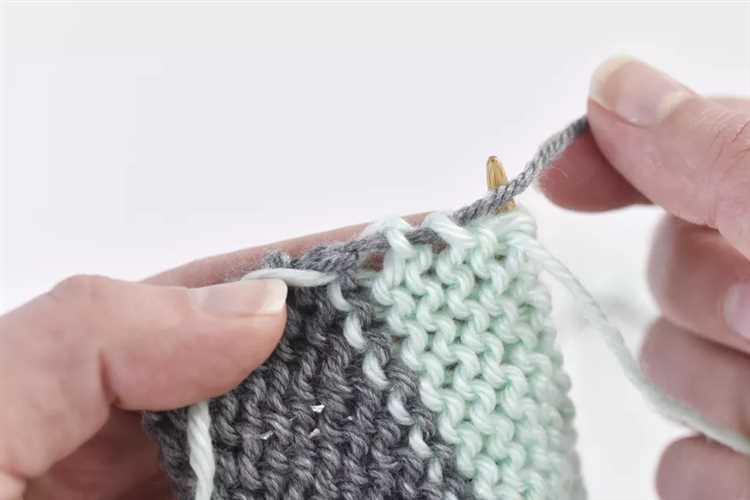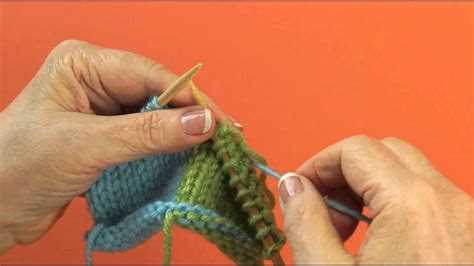Knitting is a versatile and creative craft that allows you to create beautiful and unique garments and accessories. One technique that can elevate your knitting projects is changing yarn colors. By adding new colors to your work, you can create intricate patterns, gradients, and visual interest. In this step-by-step guide, we will walk you through the process of changing yarn colors like a pro.
Step 1: Planning and Preparation
Before you start knitting with a new color, it is important to plan your design and gather all the necessary materials. Decide on the color scheme and pattern you want to achieve and choose the appropriate yarn colors. Make sure you have enough yarn in each color to complete your project.
Pro tip: If you want to create a seamless transition between colors, consider using a gradual gradient yarn or blending multiple strands of yarn together.
Step 2: Ending the Current Color
To transition to a new yarn color, you need to finish working with the current color. Knit until you reach the desired point to change colors, then insert the right needle into the next stitch and bring the new yarn over the needle. Make a loop with the new yarn and pull it through the stitch, securing the new color. Cut the old yarn, leaving a tail for weaving in later.
Pro tip: To prevent loose loops or gaps between colors, give the old yarn a slight tug before pulling the new color through. This will help snug up the stitch and maintain an even tension.
Step 3: Working with the New Color
Once you have secured the new yarn, continue knitting with the new color as instructed in your pattern. It is essential to maintain an even tension and avoid loose stitches when changing colors. To create clean color changes, keep the old yarn and new yarn along the edge of your knitting and twist them together every few stitches.
Pro tip: If you are using multiple colors in a specific pattern, consider using stitch markers to help you keep track of where to change colors.
By following these step-by-step instructions, you can change yarn colors like a pro and take your knitting projects to the next level. Experiment with different color combinations and patterns to create beautiful and eye-catching designs. Happy knitting!
Gather Your Materials
Before starting the process of changing yarn colors in your knitting project, make sure you have all the necessary materials at hand:
- Current Yarn: The yarn you are currently working with.
- New Yarn: The yarn you want to change to.
- Knitting Needles: The appropriate needles for your project.
- Tapestry Needle: A needle with a large eye for weaving in the loose ends of yarn.
- Scissors: To cut the yarn.
It’s essential to have the new yarn ready before starting the color change to ensure a smooth transition and prevent any interruptions in your knitting flow.
Additionally, you may want to consider the following:
- Yarn Weight and Fiber: Choose a new yarn that matches the weight and fiber of your current yarn to maintain consistency in your project.
- Color Contrast: If you want a dramatic color change, choose a new yarn with a significant contrast to your current yarn. Alternatively, for a more subtle transition, select a new yarn that has a similar tone or hue.
- Yarn Tension: Pay attention to the tension of your knitting to ensure that both yarns are knitted consistently. Adjust your tension if necessary.
By gathering all the essential materials and considering these factors, you’ll be well-prepared to change yarn colors in your knitting project seamlessly.
Start with a Slip Stitch
Before you change yarn colors, it’s helpful to start with a slip stitch to secure the new color and prevent any gaps or loose stitches. Here’s how you can do it:
-
Step 1: Hold the new color in your right hand and make a slip knot.
-
Step 2: Insert the right needle into the first stitch of the row, as if to purl.
-
Step 3: Slip the new color yarn onto the right needle, bringing it behind the first color yarn.
-
Step 4: Bring the right needle with both yarns through the stitch, creating a knit stitch with the new color.
-
Step 5: Pull both color yarns gently to tighten the stitch.
The slip stitch will anchor the new color yarn and ensure that the transition is smooth and seamless. It’s important to maintain tension in the yarn throughout this process to avoid loose stitches or gaps in your knitting.
Bring in the New Color
Once you’ve reached the point in your knitting project where you want to change colors, follow these steps:
- Remove the old yarn from the working needle, leaving a tail of about 6 inches.
- Take the new yarn and leave a tail of about 6 inches as well.
- Hold the old yarn and the new yarn together, with the new yarn in your desired hand (left or right).
- Using the new yarn, make a slipknot and place it on the working needle. This will create a loop with both yarns.
- Tighten the slipknot by pulling the tails of both yarns until the loop is snug.
- Continue knitting with the new yarn, making sure to tighten the first few stitches to secure the color change.
It’s important to note that you may need to weave in the tails of the old and new yarn later to ensure they are secure and won’t unravel. This can be done using a yarn needle or by knitting the tails into the fabric as you go along.
When changing colors, it’s also helpful to keep track of which row or stitch you made the color change on. This can be done by placing a stitch marker or making a note on your pattern.
Remember to practice changing colors on a small swatch before attempting it on a larger project. With time and experience, you’ll become more confident in your ability to change yarn colors like a pro!
Secure the Yarn Ends
Once you’ve changed yarn colors in your knitting project, it’s important to secure the yarn ends to prevent them from unraveling and coming undone. Here’s how you can do it:
- Weave in the Ends: Thread the loose yarn end onto a yarn needle. Carefully weave the needle through the stitches on the wrong side of your knitting, following the path of the yarn for a few inches. This will secure the yarn in place and keep it from unraveling.
- Tie a Knot: If you’re using a yarn that is prone to unraveling, or if you want to be extra cautious, you can tie a small knot at the end of the yarn. Make sure the knot is tight, but not so tight that it distorts the fabric or creates a bump.
- Trim the Excess: Once the yarn end is secured and knotted (if desired), use a pair of scissors to carefully trim any excess yarn. Be careful not to cut too close to the fabric, as this may cause the yarn to come undone.
By securing the yarn ends properly, you can ensure that your color changes stay in place and your knitting project looks neat and professional.
Knit the Next Row
After securing the new color yarn, it’s time to knit the next row. Here’s a step-by-step guide on how to do it:
- Hold the knitting needles with the active stitches in your left hand and the working yarn (the one you just added) in your right hand.
- Insert the right needle into the first stitch as if you were going to knit it, but instead of wrapping the old color yarn, use the new color yarn.
- With the new color yarn, wrap it around the right needle counterclockwise.
- Pull the new color yarn through the first stitch, just as you would normally do when knitting.
- Slide the old color yarn off the left needle, leaving the new color yarn as the active stitch on the right needle.
- Repeat this process for each stitch across the row, always using the new color yarn instead of the old color yarn.
- Once you have knitted all the stitches in the row with the new color yarn, you can either cut the old color yarn or carry it up the side of your work if you will be using it again soon.
Remember to keep the tension consistent throughout the row to ensure an even and uniform appearance. Take your time and practice this technique, and soon you’ll be changing yarn colors in your knitting like a pro!
Integrate the New Color
Once you have joined your new yarn color to your knitting project, it’s time to integrate it seamlessly into your work. Here are the steps to follow:
-
Continue knitting: Start knitting with the new color just as you would with the previous color. Work the next row or round according to your knitting pattern.
-
Carry the unused yarn: To prevent loose floats or gaps in your work, carry the unused yarn along the edge of your knitting. Hold it along the backside of your work, making sure to keep it loose enough so it doesn’t pull or pucker the stitches.
-
Weave in loose ends: Once you have knitted a few rows with the new color, you can start weaving in the loose ends of the old and new yarn. Use a tapestry needle to carefully thread the ends through the stitches and trim any excess yarn.
-
Avoid color jog: If you’re knitting in the round, you may notice a slight shift or “jog” where the new color begins. To minimize this visual discrepancy, you can use techniques such as the “jogless jog” or “slip stitch jog” to create a smoother transition between colors.
-
Create stripes or color patterns: If you want to incorporate multiple colors or create stripes or patterns, repeat the process of changing yarn colors at the desired intervals or according to your pattern instructions.
-
Keep track of your color changes: If you are following a specific color pattern or sequence, it’s helpful to keep notes or use stitch markers to track when and where you should change colors. This will ensure consistency and accuracy in your knitting project.
By following these steps and practicing the techniques, you can change yarn colors in your knitting project like a pro. Remember to take your time and be patient as you integrate the new color to achieve a polished and seamless result.
Alternate Between Colors
When changing colors in your knitting project, it’s important to know how to alternate between colors properly to achieve a clean and neat color transition. Here’s a step-by-step guide on how to do it like a pro:
- Finish the last stitch with the old color: Before you start working with the new color, make sure to finish the last stitch with the old color. This will help secure the tail end of the old yarn and prevent it from unraveling.
- Hold the new color: Hold the new color yarn in your right hand and position it over your left-hand needle.
- Insert the right-hand needle: Insert the right-hand needle into the next stitch.
- Wrap the new color: Wrap the new color yarn around the right-hand needle and bring it through the stitch, just like you would with the old color.
- Continue knitting: Continue knitting with the new color as you normally would, following the pattern instructions.
- Carry the unused color: As you knit with the new color, carry the unused color yarn on the wrong side of the work. This will prevent it from getting tangled or loose.
- Switch between colors as needed: When the pattern calls for a color change, simply repeat steps 2-5 to switch between colors.
- Weave in the loose ends: Once you’ve finished knitting, make sure to weave in the loose ends of both colors to secure them. This will give your project a polished and professional look.
By following these steps, you’ll be able to alternate between colors smoothly and seamlessly in your knitting projects. Practice makes perfect, so don’t be discouraged if it takes a few tries to get the hang of it. Happy knitting!
Finishing Touches: Weaving in the Ends
Before you can fully admire your color-changing masterpiece, you need to weave in the loose ends of yarn that were created when you changed colors. Here’s how to do it:
- Thread the yarn needle: Select a yarn needle that has a large eye, making it easier to thread the yarn through. Cut a length of yarn, approximately 6 inches long, and thread it through the needle.
- Identify the loose ends: Examine your knitting project and locate the loose ends of yarn that were left when you changed colors. These loose ends will typically be at the edges of your color sections.
- Weave in the ends: Start by inserting the needle into the edge of the knitted fabric, near one of the loose ends. Pull the needle through, leaving a small loop of yarn on the backside of the fabric.
- Secure the loop: Insert the needle through the loop of yarn on the backside of the fabric, pulling it tight to secure the loose end. This will prevent it from unraveling.
- Weave the remaining yarn: Continue weaving the needle and yarn through the fabric, following the direction of the knitting stitches. As you go, make sure to alternate the direction of the needle, going both horizontally and vertically, to ensure a secure weave.
- Cut off any excess yarn: Once you have woven in the loose end for a sufficient length, cut off any excess yarn, leaving a small tail that blends in with the fabric.
- Repeat for other loose ends: Repeat this process for any other loose ends of yarn that need to be woven in. Take your time and be thorough to ensure a finished project that looks neat and professional.
By weaving in the loose ends, you are securing the yarn and preventing any potential unraveling or fraying. This finishing touch gives your color-changing knitting a polished look and ensures that your project will stand the test of time. Now you can fully enjoy your beautiful creation!
FAQ:
What is the purpose of changing yarn colors when knitting?
The purpose of changing yarn colors when knitting is to create visually appealing patterns or designs in your knitted piece. It allows you to incorporate multiple colors in your project and add more complexity to your knitting.
Can I change yarn colors in the middle of a row?
Yes, you can change yarn colors in the middle of a row. However, it’s important to note that it can create a visible line or seam in your knitting. To avoid this, it’s recommended to change colors at the beginning of a new row or round.
What is the best method for changing yarn colors in knitting?
There are several methods for changing yarn colors in knitting, but the most common and effective method is the “join-as-you-go” method. This involves knitting the last stitch of the old color together with the first stitch of the new color to create a smooth and seamless transition.
Are there any tips for weaving in the loose ends when changing yarn colors?
When changing yarn colors, it’s important to weave in the loose ends to secure them and prevent unraveling. One tip for weaving in ends is to use a tapestry needle and thread the loose end through the nearby stitches in a zigzag pattern to ensure it stays in place. It’s also helpful to leave a slightly longer tail when changing colors to make weaving in the ends easier.


